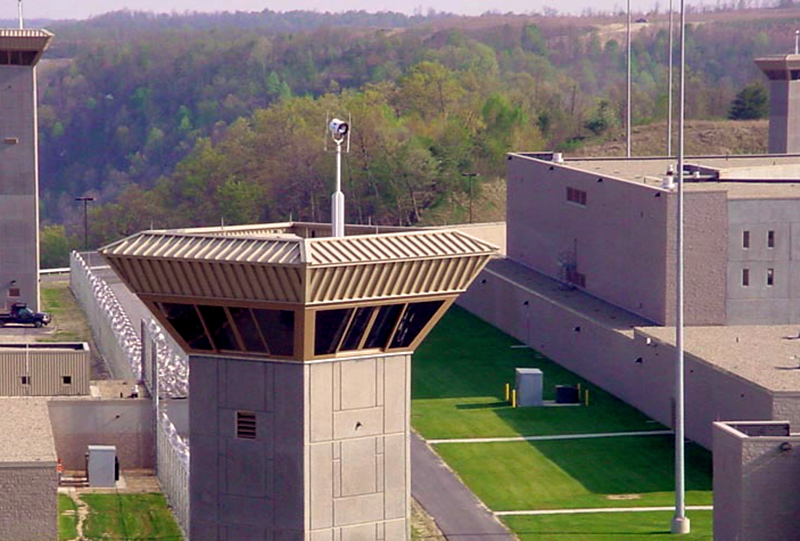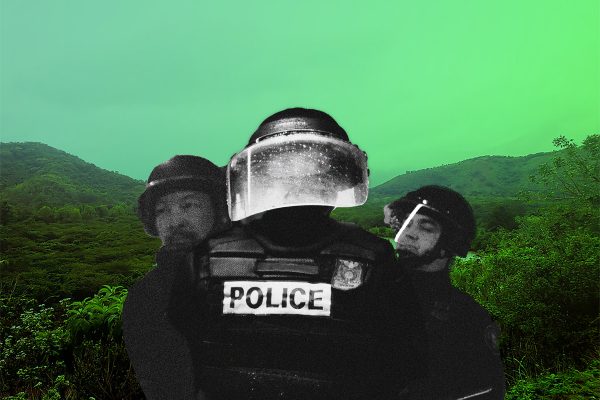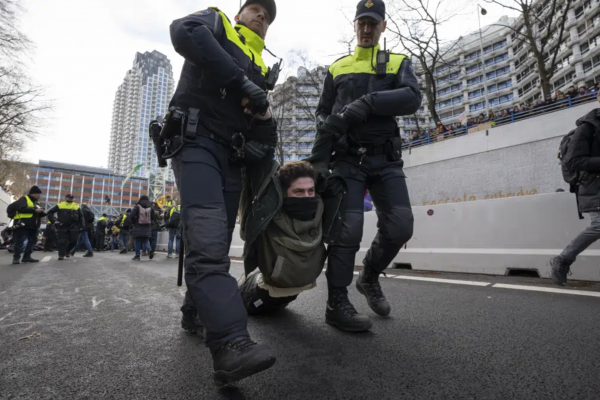On March 30, Attorney General Jeff Sessions called U.S. Congressman Harold “Hal” Rogers to personally congratulate him: a new federal prison had been approved to be built in Rogers’s home district of Eastern Kentucky (KY-5). Sited on a former coal mine in Letcher County, Kentucky, U.S. Penitentiary (USP) Letcher will be a 1,200-bed high security prison. That evening, the Friday before Easter, Rogers posted gleefully on Facebook, “It is certainly a Good Friday in Eastern Kentucky!”
Rogers represents one of the persistently poorest congressional districts in the nation; it is now also in the middle of a precipitous collapse of the regional coal industry. Since the early 1990s, Rogers—the “Prince of Pork,” who has been critiqued on both the right and left for his use of earmarks—has capitalized on the rapid expansion of our nation’s prison system, making prison building one of his primary strategies for economic development. USP Letcher will be the fourth federal prison built in Eastern Kentucky since 1992, owing largely to Rogers’s tenure on the powerful House Appropriations Committee.
Congress has committed half a billion dollars to build a prison that even the Bureau of Prisons does not think is necessary.
But this latest prison project almost did not make it out of Congress. After over a decade of planning efforts, $444 million was secured for its construction in the FY 2016 budget. Then, in a surprise twist, the Department of Justice rescinded the funding from its FY 2018 budget proposal. In a congressional budget hearing on the matter, U.S. Deputy Attorney General Rod Rosenstein noted the 14 percent decline in the federal prison population in recent years and told committee members that, “given the current volume of inmates and given the projections for the future, the Bureau of Prisons just felt that we didn’t need the prison at this time.” This reasoning, combined with concerns over the rising federal deficit and bipartisan agreement on the need for criminal justice reform, seemed to signal the end for USP Letcher—and perhaps even an end to the era of endless prison growth.
But, then, in the 2018 Consolidated Appropriations Act passed on March 23, President Donald Trump not only reinstated the full amount but also added an additional $60 million, for a total of $510 million for the prison project. This means USP Letcher will be the most expensive federal prison ever built, surpassing USP Big Sandy, just two counties north of Letcher, whose expense rose significantly when the prison was found to be sinking into the abandoned coal mine beneath it. In short, Congress has just committed half a billion dollars to build a prison that even the Bureau of Prisons does not think is necessary.
The push to revive the prison reflects Sessions’s determination to steer the White House back toward the “law and order” politics of the past, which were instrumental in creating our current crisis of mass incarceration. With 2.2 million people behind bars today and 11 million cycling through jails every year, the United States incarcerates more people, and at a drastically higher rate, than any other country in the world. Building 1,200 more prison beds reflects our dependency on this system of racialized social control, revealing not only deeply held assumptions about crime and punishment, but also what we believe is possible for, and deserved in, rural America.
The phenomenon of rural prison-building is a product of our nation’s failure to adequately understand these regions or allow them viable futures. Since the 1980s, 350 new prisons have been built in rural areas of the United States. These prisons serve as putative solutions to the problems of deindustrialization. But building institutions of captivity and exclusion resolve crises only insofar as they incapacitate members of racialized and overpoliced communities while offering precarious, undesirable, and relatively few employment opportunities to host communities. This is what we are told to expect and believe is the last hope for poor rural areas around the country, including in Appalachia.
Rural prison-building is a product of our nation’s failure to adequately understand these regions or allow them viable futures.
Our limitations when it comes to envisioning a future for Appalachia have their basis in an extensive history of negative representations. Appalachia has long been built in the national imagination as culturally and even genetically deficient, from “local color” writers in the later decades of the nineteenth century, who first popularized a narrative of Appalachian backwardness; to War on Poverty–era reporting that declared “a fearsome . . . erosion of the character of the people”; to J. D. Vance’s 2016 bestselling memoir Hillbilly Elegy, with its assertions about biological and cultural depravity. Such narratives of individual failure and family dysfunction conceal and sanction our nation’s exploitation of Appalachia as a site of material extraction and disposal.
This legacy was most recently expressed in reporting on the Letcher County prison proposal. Just days before the Bureau of Prisons gave final approval for the project, NBC News published an article about the prison project titled “Does American Need Another Prison? It May be this Rural County’s Only Chance at Survival.” The story chronicles the hopes of some Letcher County residents that the prison can resurrect their community. The accompanying video, which is six minutes long, allots a total of nine seconds to mentioning that, first, data on the economic impact of prison building is disputable, and second, that some residents oppose the prison. This token coverage of both empirical data and local opposition has the effect of making it seem that the prison enjoys near-universal support, and that it is key to the redemption of Letcher County.
In her recent book, What You Are Getting Wrong About Appalachia, historian Elizabeth Catte names the most recent trend of Appalachian reporting as the “Trump Country” genre. Such pieces rely on representations of dysfunction and disaffection to explain the 2016 election. This reporting often ignores germane pieces of information in order to work within the genre, including the fact that the median income of Trump voters was over $72,000 a year, more than twice the median income of most counties in Eastern Kentucky. “Trump Country” pieces hinge on a particular narrative of the hope Trump symbolized for poor whites amidst economic devastation. In the NBC coverage, the prison stands in for the president and symbolizes promise and redemption for the struggling region.
Such coverage dismisses facts that, if included, would tell a very different story.
The data is clear: in economically struggling areas, prisons fail to provide the promised growth. Eastern Kentucky counties with federal prisons remain among the poorest in the nation.
First, the data nationally and regionally is clear: in economically struggling areas, prisons fail to provide the promised growth. Other Eastern Kentucky communities that already host prisons provide an instructive lesson in this regard. Rogers worked to bring federal prisons to Clay, Martin, and McCreary Counties in 1992, 2003, and 2004 respectively. Today, all three are on the list of the top ten poorest counties in Kentucky; in 2015 Clay and McCreary ranked first and second. All three are also among the thirty poorest counties in the United States. According to the U.S. Census Bureau’s 2016 estimates, over 39 percent of the population in each county lives below the poverty line, over triple the national average of 12.7 percent. Furthermore, the closing of a prison in adjacent Floyd County, as well as the closing of rural prisons in other states such as New York, explodes the chilling myth, often circulated by boosters, that prisons are a “recession proof” industry.
Second, opposition to the prison is actually robust and diverse. On the ground in Letcher County, some residents began organizing as the Letcher Governance Project (LGP) in response to the closed planning process for the proposed prison. According to the group, this process “has largely been done by wealthy and powerful people in the county, without the input of local landowners and citizens.” The LGP advocates for inclusive and transparent local democracy, and opposes the prison, instead calling for more creative investment in “community driven solutions that foster healing our land and people,” such as centers for drug rehabilitation, cancer treatment, mined land reclamation, and investment in small business development and renewable energy. The group argues that “study after study has shown that prisons do not create the amount of jobs or economic benefits that officials often tout” and insists that “Appalachia deserves real economic alternatives that are not built on human suffering.” Members interrupted a regional innovation summit hosted by Rogers holding signs that read “Prisons Are Not Innovation” and “#our444million,” a hashtag that demands better, locally-directed use of the prison’s anticipated cost.
Other local residents have been outspoken over concerns regarding land use and endangered habitats, including threats posed to a rare old growth forest less than a mile away, as well as anticipated impact to water quality, noise and light pollution, and increased traffic. National organizations, including the Sierra Club, the Center for Biological Diversity, the Human Rights Defense Center, and Color of Change have also challenged the prison on the grounds that it risks increased water and ground pollution and environmentally unsafe conditions for prisoners, all in the name of unnecessary correctional expansion. In fact, according to Panagioti Tsolkas, the coordinator of the Prison Ecology Project, which was central to the environmental challenges to the prison, the official record shows that more than 20,000 individual comments were submitted against the prison during the Federal Environmental Impact Statement (EIS) process, in addition to expert testimonies and form letters with hundreds of signatures. Local and national actors successfully pursued a coalitional politics that forced multiple revisions to the plans and stalled the prison’s advance for thirty months. It is the very kind of opposition that has a long history in Appalachia and is consistently written out of journalistic accounts of the region: from the early twentieth-century mine wars for unionization, to organizing for full employment, welfare rights, black lung benefits, and the abolition of strip mining and mountaintop removal, the region has a rich history of challenging the power structures of our nation.
Addressing white poverty by incarcerating people of color exacerbates tensions between marginalized communities while curtailing the potential for multiracial solidarity.
Third, reporting on the prison’s promise to Appalachia fails to acknowledge that 1,200 prison beds represent 1,200 human lives. When we limit the discussion of rural prisons solely to a debate about the cost–benefit for the host community, we fail to ask the most important question: what will building this prison mean for those who are incarcerated within it? The proposed site for USP Letcher is off of a two-lane backcountry road; there is no public transportation, nor is there an airport within two hours of the location. According to the Sentencing Project, we can expect that 63 percent of these 1,200 people will be parents of minors; 84 percent of those parents will be incarcerated more than a hundred miles from their children and nearly half of them will not have a single visit from their children while they are incarcerated. Numerous studies have shown that maintaining family relationships is key to successful reentry, and to the well-being of children with incarcerated parents. Continuing to build prisons in remote, inaccessible locations makes family contact nearly impossible.
There are also stark ethnic and racial dynamics to consider. The federal prison population is 39 percent black and 33 percent Latinx. While rural prison towns are often multiracial, Letcher County is 98 percent white. Purportedly addressing white poverty with a plan that impoverishes and incarcerates racialized populations engineers and exacerbates tensions between marginalized communities while curtailing the potential for multi-sited and multiracial solidarity.
In her foundational book, Golden Gulag, geographer Ruth Wilson Gilmore corrects the common mistake of thinking that prisons sit on the edges of society, holding marginalized people in marginal places. Instead, she notes, edges are also interfaces that can connect places, including non-contiguous places, into a relationship. In the case of Eastern Kentucky, prison-building consolidates the crises of urban and rural sacrifice zones, or what Gilmore calls “organized abandonment.” But for this very reason, the choice to build a prison in Letcher County reveals the social proximity between, and interdependency of, rural and urban struggles for justice. Indeed, the record of opposition shows what coalition building across scale and space makes possible. We would do well to follow the lead of groups such as the Letcher Governance Project, who “stand against the racist systems that lead to mass incarceration, as well as mass incarceration itself” and “advocate for a just and diversified regional economy that is not built on fossil fuel industries and prisons.”






